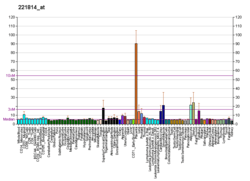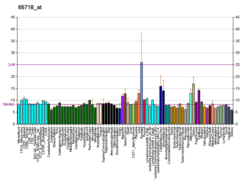GPR124
Probable G-protein coupled receptor 124 is a protein that in humans is encoded by the GPR124 gene.[5][6][7] It is a member of the adhesion-GPCR family of receptors. Family members are characterized by an extended extracellular region with a variable number of protein domains coupled to a TM7 domain via a domain known as the GPCR-Autoproteolysis INducing (GAIN) domain.[8][9][10]
Interactions
GPR124 has been shown to interact with DLG1[11] and is involved in the Wnt/β-catenin signaling pathway along with RECK.[12]
Zebrafish embryos with Gpr124 loss of function demonstrate severe angiogenic deficiencies in the central nervous system.
References
- GRCh38: Ensembl release 89: ENSG00000020181 - Ensembl, May 2017
- GRCm38: Ensembl release 89: ENSMUSG00000031486 - Ensembl, May 2017
- "Human PubMed Reference:". National Center for Biotechnology Information, U.S. National Library of Medicine.
- "Mouse PubMed Reference:". National Center for Biotechnology Information, U.S. National Library of Medicine.
- Carson-Walter EB, Watkins DN, Nanda A, Vogelstein B, Kinzler KW, St Croix B (September 2001). "Cell surface tumor endothelial markers are conserved in mice and humans". Cancer Res. 61 (18): 6649–55. PMID 11559528.
- Fredriksson R, Gloriam DE, Hoglund PJ, Lagerstrom MC, Schioth HB (February 2003). "There exist at least 30 human G-protein-coupled receptors with long Ser/Thr-rich N-termini". Biochem Biophys Res Commun. 301 (3): 725–34. doi:10.1016/S0006-291X(03)00026-3. PMID 12565841.
- "Entrez Gene: GPR124 G protein-coupled receptor 124".
- Stacey M, Yona S (2011). AdhesionGPCRs: Structure to Function (Advances in Experimental Medicine and Biology). Berlin: Springer. ISBN 1-4419-7912-3.
- Fredriksson R, Lagerstrom MC, Hoglund PJ, Schioth HB (Nov 2002). "Novel human G protein-coupled receptors with long N-terminals containing GPS domains and Ser/Thr-rich regions". FEBS Lett. 531 (3): 407–14. doi:10.1016/S0014-5793(02)03574-3. PMID 12435584.
- Araç D, Boucard AA, Bolliger MF, Nguyen J, Soltis SM, Südhof TC, Brunger AT (March 2012). "A novel evolutionarily conserved domain of cell-adhesion GPCRs mediates autoproteolysis". EMBO J. 31 (6): 1364–78. doi:10.1038/emboj.2012.26. PMC 3321182. PMID 22333914.
- Yamamoto Y, Irie K, Asada M, Mino A, Mandai K, Takai Y (May 2004). "Direct binding of the human homologue of the Drosophila disc large tumor suppressor gene to seven-pass transmembrane proteins, tumor endothelial marker 5 (TEM5), and a novel TEM5-like protein". Oncogene. 23 (22): 3889–97. doi:10.1038/sj.onc.1207495. PMID 15021905.
- Vanhollebeke B, Stone OA, Bostaille N, Cho C, Zhou Y, Maquet E, et al. (June 2015). Rossant J (ed.). "Tip cell-specific requirement for an atypical Gpr124- and Reck-dependent Wnt/β-catenin pathway during brain angiogenesis". eLife. 4: e06489. doi:10.7554/eLife.06489. PMID 26051822.
Further reading
- Nakajima D, Okazaki N, Yamakawa H, et al. (2003). "Construction of expression-ready cDNA clones for KIAA genes: manual curation of 330 KIAA cDNA clones". DNA Res. 9 (3): 99–106. doi:10.1093/dnares/9.3.99. PMID 12168954.
- Nagase T, Kikuno R, Ishikawa K, et al. (2000). "Prediction of the coding sequences of unidentified human genes. XVII. The complete sequences of 100 new cDNA clones from brain which code for large proteins in vitro". DNA Res. 7 (2): 143–50. doi:10.1093/dnares/7.2.143. PMID 10819331.
- Strausberg RL, Feingold EA, Grouse LH, et al. (2003). "Generation and initial analysis of more than 15,000 full-length human and mouse cDNA sequences". Proc. Natl. Acad. Sci. U.S.A. 99 (26): 16899–903. doi:10.1073/pnas.242603899. PMC 139241. PMID 12477932.
- Yamamoto Y, Irie K, Asada M, et al. (2004). "Direct binding of the human homologue of the Drosophila disc large tumor suppressor gene to seven-pass transmembrane proteins, tumor endothelial marker 5 (TEM5), and a novel TEM5-like protein". Oncogene. 23 (22): 3889–97. doi:10.1038/sj.onc.1207495. PMID 15021905.
- Bjarnadóttir TK, Fredriksson R, Höglund PJ, et al. (2005). "The human and mouse repertoire of the adhesion family of G-protein-coupled receptors". Genomics. 84 (1): 23–33. doi:10.1016/j.ygeno.2003.12.004. PMID 15203201.
- Vallon M, Essler M (2006). "Proteolytically processed soluble tumor endothelial marker (TEM) 5 mediates endothelial cell survival during angiogenesis by linking integrin alpha(v)beta3 to glycosaminoglycans". J. Biol. Chem. 281 (45): 34179–88. doi:10.1074/jbc.M605291200. PMID 16982628.
This article is issued from Wikipedia. The text is licensed under Creative Commons - Attribution - Sharealike. Additional terms may apply for the media files.





